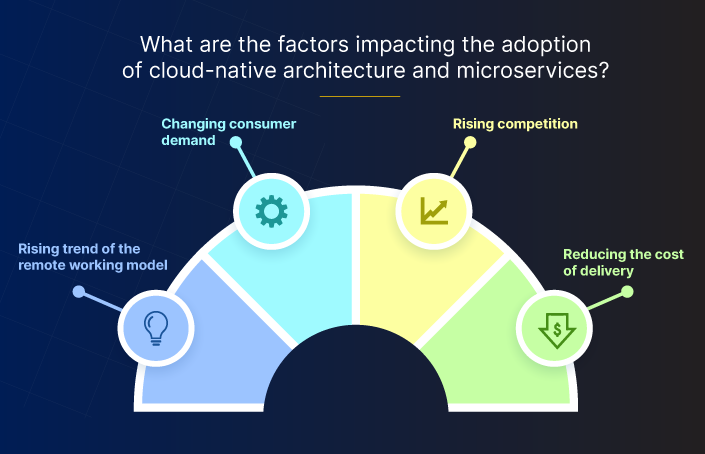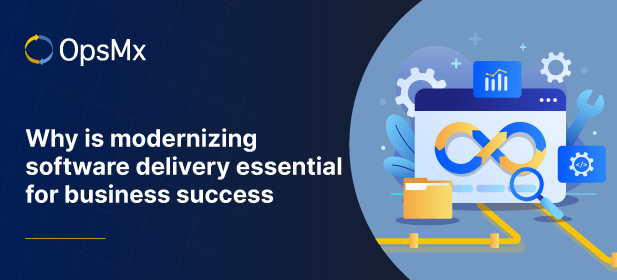Modern IT organizations are capitalizing on cloud-native applications to build business resilience and operate with minimal disruptions. Cloud-native architecture has equipped organizations to be scalable, flexible, and innovative. During the post-pandemic era, several factors have triggered the adoption of cloud-native architecture and microservices. For instance, cloud-native helps organizations meet customer expectations at a lower cost. As a result, an increasing number of businesses want to rapidly ship products to the end audience and serve them using the cloud. However, adopting these technologies is no easy feat.
Even after modernizing their software delivery process through continuous delivery platforms, teams must overcome several complexities and challenges. One such challenge is battling inefficiency among distributed teams. Overcoming this major challenge can help IT organizations to achieve their software delivery performance goals.
How can businesses achieve modernization?
The adoption of cloud-native architecture is a key factor that can drive modernization for businesses. But what is cloud-native architecture and how can it help organizations in modernizing software delivery?
According to Wikipedia, “Cloud-native computing is an approach in software development that utilizes cloud computing to “build and run scalable applications in modern, dynamic environments such as public, private, and hybrid clouds”. Technologies such as containers, microservices, serverless functions, and immutable infrastructure, deployed via declarative code are common elements of this architectural style.” The principles of cloud-native architecture are governed by twelve factors. Applications built upon these principles can be deployed and are rapidly scalable and add features to react quickly to market changes. Therefore, by moving applications to the cloud organizations can achieve modernization.
According to a research survey by Avanade conducted across 800 senior IT decision-makers in global enterprises, 80% of the respondents believe that failing to modernize applications and IT infrastructure will negatively affect the long-term growth of their business.
In this blog, we will cover why enterprises should prioritize modernizing the software delivery process, the challenges that enterprises encounter while doing so, the solution that can help them overcome these challenges, and the architecture and benefits of the solution. We will also learn how the solution helps enterprises to drive efficiency across their software delivery pipeline.
Let us learn about the factors that trigger the need for adopting cloud-native architecture and microservices.
What are the factors impacting the adoption of cloud-native architecture and microservices?

Rising trend of the remote working model
The COVID-19 pandemic has changed the way organizations operate. Today, a large part of the workforce has adopted the remote or hybrid working model, which has increased the demand for cloud-based technologies and microservices.
Changing consumer demand
Due to the rising trend of remote/hybrid business operations, organizations need to enable their workforce quickly at a low cost. This is where cloud-based and microservices come into the picture. It enables businesses to deliver software applications quickly at a fraction of the cost.
Rising competition
Cloud-based architecture has a faster time to deliver in the market. This is why an increasing number of businesses are developing and offering their services in the marketplace.
Reducing the cost of delivery
The renting model of cloud computing has made it easy for organizations to avoid the upfront cost of owning IT infrastructure. So, now companies can deliver a vast number of services quickly at a reduced cost.
As a result of all these factors, organizations are forced to deliver software at scale and at velocity. Unfortunately, the entire software delivery process breaks when IT teams try to deliver at speed and scale without a robust platform.
Conclusion
By modernizing software delivery, organizations get the chance to optimize their operational and cost efficiencies offered by the cloud. This is mostly because they can leverage the benefits of the cloud such as elasticity and scalability that can result in extensive savings and ultimately result in business success. Plus, automating processes helps to eliminate human errors which improve the overall efficiency of teams across the organization.
The OpsMx Enterprise for Spinnaker (OES) platform is a highly scalable, extensible secure, multi-cloud continuous delivery module that helps you release software changes with high velocity and confidence. OES empowers teams to modernize their software delivery: release more quickly, reduce risk, and cut costs. It’s Delivery Intelligence module, Autopilot automates release verification; continuous governance and policy, real-time approvals, and enterprise-wide traceability and insights.

0 Comments